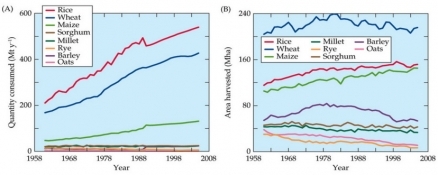Rice production
Emissions from Rice Production
| Topics: |
Humans consume more rice (5.4 × 1014 grams in 2005) than any other cereal, and rice is grown on more than 150 million hectares worldwide. Most of this rice is wetland rice. Cultivation of wetland rice involves planting into shallow standing water and raising the water level as the crop grows. This eliminates competition from most weeds as well as insures an adequate amount of water for this water demanding crop. Rice fields, or paddies, are allowed to dry as the crop matures. Soil microorganisms under anaerobic, flooded conditions harvest the energy released during the breakdown of organic carbon compounds into methane (CH4), a process known as methanogenesis.
This process emits as much as 700 kg of carbon equivalents per hectare [1], or 1.5% of the world’s greenhouse gas emissions from human activities. [2] Mitigation options for rice production are few. Water management practices, which drain paddies during the middle of the growing season instead of keeping them possibility underwater continuously, diminish CH4 emissions by 15% to 59%. [3] These practices depend on the availability of additional water to reflood the paddies and add from 5% to 9% to production costs. [4] Rice cultivars may differ in their root exudations of organic carbon and thus in their support for methanogenesis, but evidence that these differences influence CH4 emissions under field conditions is inconclusive. [5]
[1] Wassmann, R. and H. Pathak (2007) Introducing greenhouse gas mitigation as a development o ective in rice-based agriculture: II. Cost-benefit assessment for different technologies, regions and scales. Agricultural Systems 94:826-840.
[2] Neue, H. U. (1997) Fluxes of methane from rice fields and potential for mitigation. Soil Use and Management 13:258-267.
[3] Corton, T. M., J. B. Bajita, F. S. Grospe, R. R. Pamplona, C. A. Assis, R. Wassmann, R. S. Lantin, and L. V. Buendia (2000) Methane emission from irrigated and intensively managed rice fields in Central Luzon (Philippines). Nutrient Cycling in Agroecosystems 58:37-53 ; Curtis, P. S. and X. Z. Wang (1998) A meta-analysis of elevated CO2 effects on woody plant mass, form, and physiology. Oecologia 113:299-313.; Wassmann, R. and H. Pathak (2007) Introducing greenhouse gas mitigation as a development o ective in rice-based agriculture: II. Cost-benefit assessment for different technologies, regions and scales. Agricultural Systems 94:826-840.
[4] Smith, P., D. Martino, Z. Cai, D. Gwary, H. Janzen, P. Kumar, B. McCarl, S. Ogle, F. >O’Mara, C. Rice, B. Scholes, and O. Sirotenko (2007) Agriculture. In: Climate Change 2007: Mitigation. Contribution of Working Group III to the Fourth Assessment Report of the Intergovernmental Panel on Climate Change, Metz, B., O. R. Davidson, P. R. Bosch, R. Dave, and L. A. Meyer, eds. Cambridge University Press, New York. pp. 497-540.
[5] Wassmann, R., M. S. Aulakh, R. S. Lantin, H. Rennenberg, and J. B. Aduna (2002) Methane emission patterns from rice fields planted to several rice cultivars for nine seasons. Nutrient Cycling in Agroecosystems 64:111-124.
This is an excerpt from the book Global Climate Change: Convergence of Disciplines by Dr. Arnold J. Bloom and taken from UCVerse of the University of California.
©2010 Sinauer Associates and UC Regents
